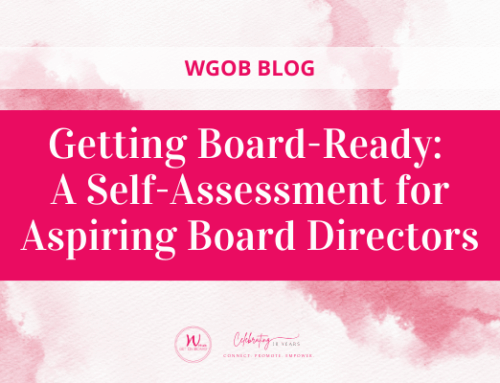During our sold out Women Get On Board Toronto event that BMO Bank of Montreal our National Strategic Partner hosted, an attentive audience listened to the engaging discussions on the topic of Evaluating Financing Solutions in the Boardroom.
Panelists at this event included Steven Jensen, Head, Sales Enablement, BMO Canadian Commercial Bank, Hesham Abourahma, Regional Vice President, Real Estate Finance, Ontario and Julia Davidson, Managing Director, BMO Sponsor Finance.
From board member responsibilities and financial risk consideration to capital structure, debt definition and company life cycles, the panelists provided an insightful discussion on the many ways the board can evaluate strategic financing solutions to make informed decisions.
1. Overview of Board Responsibilities and Financial Risk Consideration
Steven Jensen opened his discussion on this topic by first mentioning that he knows what strategies tend to work in the boardroom because he has been privy to seeing what happens to a company when its board members do not properly deal with their oversight role on financing solutions.
“One of the observations (from) dealing with these different boards (is that) one of the things I frequently see breakdown is people not questioning what’s put in front of them,” Jensen noted.
In order to mitigate this problem, Jensen said that Board of Directors need to provide leadership, direction and a clear-cut vision that will trickle down to the company or organization, as well as its employees. Jensen revealed that he can walk into a boardroom and within 10 minutes know if it’s operating from a healthy environment or not. Because of this, it is important that board members keep up their fiduciary duties – to act honestly, in a diligent manner, in good faith and in the best interests of the corporation. By doing this, boards, companies and organizations will be creating good governance practices.
Following that point, Jensen said that the second most common thing he sees go wrong in the boardroom is that people sometimes treat serving on a board as a vanity project – they are present for personal gain and do not always have the greater good of the board (and in turn the company or organization) at heart.
Finally, Jensen discussed financial risk in the boardroom, stressing the importance of being able to say no to situations where financial risk seems to outweigh the potential reward. “I think it’s important to question it in that uncomfortable way – why are we doing this and what is it taking away from the mandate of the company?”
2. Capital Structure, Debt Definitions and Company Life Cycle
Shifting to structure and debt, there are two main types of debt within the capital structure. The first is senior debt, which, as Hesham Abourahma noted, is the cheapest form of debt that you can get as a company (typically around 5 %). This type of debt is the cheapest because, “the lenders have first charge on the assets.” Abourahma also stated that senior debt is the safest choice within the capital structure. The second type of debt is subordinate debt. Abourahma describes this as sitting between senior debt and equity and revealed, “This form of debt is a little higher on the risk curve.” Interest rate on this type of debt is typically around 12 percent and is a good solution to have if you don’t want to dilute your equity.
Speaking of equity, it is important to acknowledge that it is a key component to the capital structure, although it generally come with the most risk. However,
Abourahma also revealed that it tends to expose higher reward and that equity should encompass approximately 30-40 % of a company or organization’s capital structure. “The fundamental principle is that, are you sharing in the risk with your lenders? Do you have skin in the game?”
Moving on, Abourahma broke down the three different growth phases that boards can expect to see within any company stages of growth. The first stage is the initial growth phase, where any profits generated are typically reinvested into the company in order to solidify its position and help fund continued growth.
During this growth phase, it is important for the board to understand and implement both debt and equity solutions in order to see a company make it to the second stage, which is the mature growth phase.
In the mature growth phase, revenues grow quickly, and the organization may expand to new markets and are likely making a profit. During this time, it is pertinent to evaluate different types of financing, such as public vs private debt markets or asset-based lending vs cash flow lending etc.
Finally, the last growth phase is the stabilization phase. During this time, a company should be at its peak earning years and while growth may slow, earnings are strong. In addition to organic growth, organizations may start to look at acquiring, expanding or selling part or all of the company.
3. Credit and Other Considerations
To end the session, Julia Davidson addressed credit considerations and how credit transactions are structured to reflect a sound business premise and an appropriate capital structure. Davidson noted that combined with supportable business performance, the elements of a “safe-and-sound” loan structure should clearly support a borrower’s capacity to repay over a reasonable period.
According to Davidson, “safe” for banks means that they assess the underlying collateral of a company or organization, as well as the enterprise value of a business. This is done in order to gauge what type of loan they could provide while simultaneously protecting the bank.
In terms of “sound”, Davidson noted that this refers to the business and industry analysis that banks do to understand where the company stands and what different types of capital structures it has. For example, some companies in particular industries are more susceptible to cyclical swings in the market, causing them to have very different capital structures than other companies or organizations.
At this point, Davidson pointed out that it is pertinent that both the company and the lender be on the same page in terms of capital structure and which type of loan would work best for both parties. “Any of you that (serve) on boards today, what I would encourage you to do is, don’t just look at today and what your financing needs are (think about) what are you going to need six months from now, or nine months, 12 months? It’s often easier to have that discussion upfront and provide some flexibility for the future.”
In the end, the best financing solutions are made with the board’s participation.
It is important for board members to understand capital structure considerations. An engaged board should ask tough questions by determining what the company needs to grow and ensure that management has a good relationship with their lender.
Women Get On Board is a leading member-based company that connects, promotes and empowers women to corporate boards. We do this through an engaged community of women and men in Canada committed to advancing gender diversity in the boardroom.
BMO for women recognizes the power of women and their contributions to the economy and their communities. Supporting causes important to women, developing tools and resources to help them succeed, understanding their unique needs and adjusting how we work to help them to realize their financial goals are critical to being the bank that ‘gets it right’ with women.







